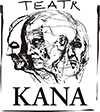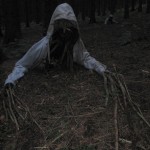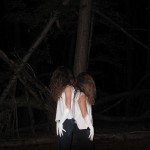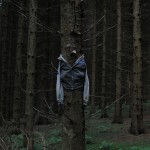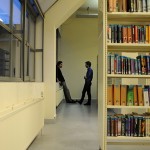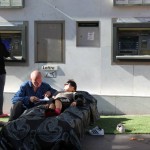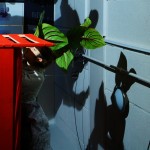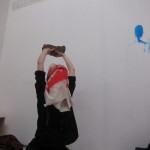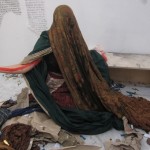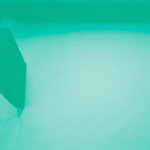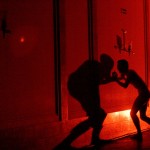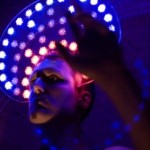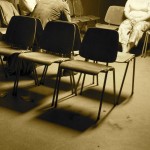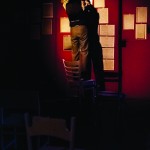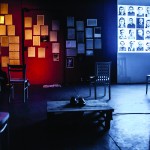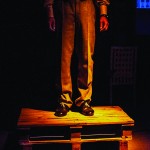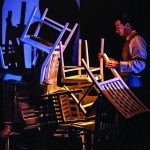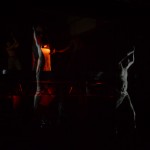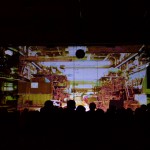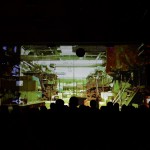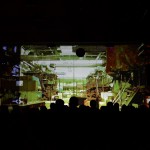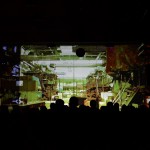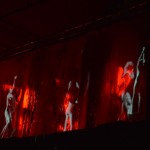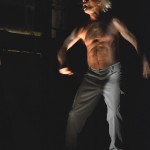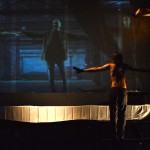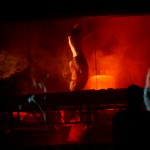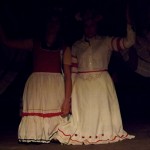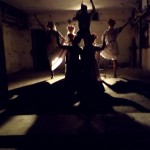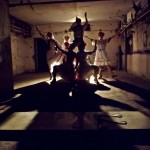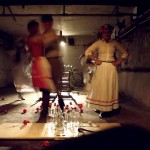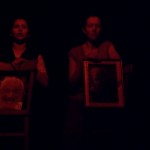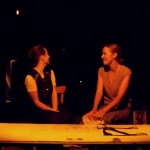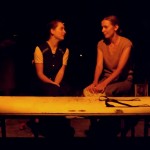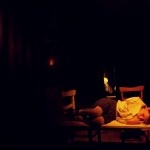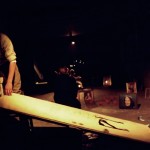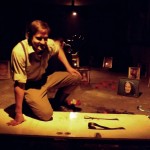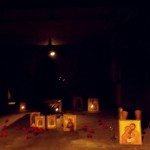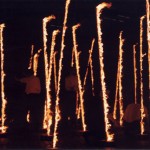NIGHT TRIPPER
(Fiksdal/ Langgård/Becker)
won Osloprisen (The Oslo Award) for Best Performance of 2012.
concept: Fiksdal/Langgård/Becker
choreography and production: Ingri Fiksdal
music: Ingvild Langgård
scenography: Signe Becker
dancers: Pernille Holden and Julie Solberg
musicians: Jørn Tore Egseth, Ane Marthe Sørlien Holen, Invild Langgård/øystein Wyller Odden and Gunhild Mathea Olaussen.
Comissioned and Produced for Up To Nature. A collaboration between brut-Wien, Black Box, In Between Time, Anti Festival and Maska. Supported by Up To Nature, The Norwegian Arts Council, Fond for lyd og bilde, Fund for performing artists and STIKK.
Night Tripper takes shape as a trail in the woods, concert performance, ritual and society event. It begins in the twilight hour and takes the audience into the night. The piece features six performers, curious instruments, numerous installation artworks, a local choir and a lot of potent spirits.
Night Tripper explores the idea of nature and animistic, as a place of both healing and destructive powers, of immanence and transcendence. Ancient mythology meets contemporary everyday life, and dream and reality merge into an otherwordly, yet tangible tale. Night Tripper draws from ideas of voodoo culture, where lingering too long at the crossroads can make true believers into divine horsemen.
TIME HAS FALLEN ASLEEP IN THE AFTERNOON SUNSHINE
with: Aaron Virdee, Bruno de Wachter, Caroline Daish, Chloe Fisher, David Helbich, Elly Clarke, Giota Bibli, Helena Polasik, Irena Radmanovic, Irini Tsava, Jan Kühling, Johan Sonnenschein, Katja Dreyer, Kristien Van den Brande, Kristine Øren, Lilia Mestre, Luigi Pignati, Mari Matre Larsen, Marit Ødegaard, Maria Psarologou, Marios Kritikopoulos, Martin Slaatto, Mette Edvardsen, Moqapi Selassie, Muna Mussie, Philip Holyman, Razan Akramawy, Rosemary Lee, Sarah Ludi, Sébastien Hendrickx, Sonia Si Ahmed, Tiziana Penna, Ulf Nilseng, Usama Zurba, Vincent Dunoyer, Wouter Krokaert, …
assistant: Maya Wilsens
production: Helga Duchamps/ duchamps vzw and Mette Edvardsen/ Athome
special thanks to: Dubbelspel (STUK Kunstencentrum & 30CC, Leuven), Kaaitheater/ Brussels, Sarah Vanhee
title: Time has fallen asleep in the afternoon sunshine is a sentence from a book by Alexander Smith appearing in Fahrenheit 451 by Ray Bradbury (1953).
The action will take place in one of Szczecin’s libraries. For this project, a group of people / performers has learnt by heart some books of their choice. Together they form a library consisting of “living books”. The “books” spend their time in the library, sitting in chairs, walking, talking to each other, gazing through the window, reading paper books from the shelves, ready to be consulted by a visitor at any time. The visitors can choose any “book” they want to read, and the “book” takes him to a special place in the library, to a cafeteria or for a walk outside the walls of the library, reciting their contents (and possibly a valid interpretation).
The idea for this library of living books comes from the science fiction novel Fahrenheit 451. It is a future vision of a society where books are forbidden because they are considered dangerous, that happiness must be obtained through an absence of knowledge and individual thought. The number 451 refers to the temperature at which book paper starts to burn. As books are forbidden in this society, an underground community of people learn books by heart in order to preserve them for the future.
Books are read to remember and written to forget. To memorise a book, or more poetically ‘to learn a book by heart’, is in a way a rewriting of that book. In the process of memorising, the reader for a moment steps into the place of the writer, or rather he/ she is becoming the book. Maybe the ability to learn a whole book by heart is relative to what book you choose, the time you invest, and perhaps your skills. But, however much or well you learn something by heart you have to keep practicing it otherwise you will forget it again. Perhaps by the time you reach the end you will have forgotten the beginning. Learning a book by heart is an ongoing activity and doing. There is nothing final or material to achieve, the practice of learning a book by heart is a continuous process of remembering and forgetting.
POWER NAP SHOP
actors: Jørgen Knudsen, Kjartan Andersen, Susanne Fjørtoft, Christina Brandt Jensen, Sunniva Skorve og Karen Eide Bøen
help from: Kulturkontakt Nord, FFUK, FFLOB, Norsk kulturråd i Bergen Kommune
It is to your benefit to sleep, to sleep well, and to sleep enough. To some the few hours of night is not enough to cover this basic need, and we have come to embrace the healthy riches of a daytime nap. Our soft beds and warm voices offer the most relaxing conditions on the market, and we provide a thoughtful journey from the waking world into restful slumber. Our naps are designed to last just long enough to refuel you with the energy you need to be renewed. Welcome to our sleepshop.
The Sleepshop: as a part of the project ‘Exit Strategy’ HGDC created their own business idea; the Happy Gorilla Power nap Shop, a social investigation where we run a shop selling powernaps or simply relaxation.
Power naps of less than 30 minutes—even those as brief as 6 to 10 minutes—restore wakefulness and promote performance and learning. The onset of sleep may initiate active memory processes of consolidation which—once triggered—remains effective even if sleep is terminated.
Considering the high level of stress in modern society we will within our business concept investigate the body in rest, as opposed to the body engaged in work or play, but not exclusively as they are interdependent. In this way the resisting body could be a body at sleep. The psychology of our costumer’s rest will be contrasted by us as the workers developing a choreography of work, a shop choreography. Dance as work, or work as dance.
On the business level the sleepshop will be a shop where the commodity sold is basically time to relax during daytime and space to make it possible. Through reading stories, wearing costumes and other artistic expressions our shop is not purely functional but also a site for dialogue, movement and above all a release from daily routines.
ONCE UPON A TIME COUNTRY
(Impure Company)
choreography by Hooman Sharifi
Impure Company is Matthew William Smith, Ida Gudbrandsen, Rikke Baewert, Ali Moini, Elika Hedayat, Hooman Sharifi
Choreographer Hooman Sharifi moved from his native Iran to Norway in 1989. He established Impure Company in 2000 and has since presented work with a commitment to sincerity and directness under the belief that art equals politics.
On these evenings Sharifi presents Once Upon a Time Country, a work created in 2009 inspired by the exchange of information about the protests surrounding the elections in Iran and the struggles of the Iranian people. Through hidden bodies that constantly change shapes, Sharifi seeks to illuminate the process of seeing, exploring where sight meets the imagination.
Once upon a time country employs an Aesthetic of a revolution and uses methods of uprising such as occupation. The performers takes the ownership of the room and makes it theirs. But in contradiction to the idea of revolution as a movement, a voice, a direction, addresses the other performers as individuals. They are not agreeing about what will happen, what they are protesting against, or what kind of expression the protest has. Perhaps they even don’t protest. They place themselves in the centre of questions they don’t know the answers to and force themselves to meet and investigate themselves in front of a public. This enables Once upon a time country to not only be violent and hard, but also vulnerable and open.
Once upon a time country is a site-specific project that is about building and transforming the room. The performance starts with “nothing”: the room is clean and organised, nothing is drawn on the walls, and nothing has happened. In the two days of the performance, the room slowly changes, but parts of what is happening there remain. Layer by layer the visual artist develops the figures on the wall. Piles of paper are collected and built, stones scratch the surface, red paint drips down the wall. Confetti spits out in the room and glues itself on the performers. Screams, songs, stories, writings, shaking, and spitting. Someone wraps themselves with layers of ornamental carpets. Others lie burried under the stones. Everything happens in a continuously dialog between the visual artist and the actions from the dancers.
Every performer has full responsibility for their actions in the room, and every one of them must find their own method of how to be and act, taking care of the being and the collectives. This form of togetherness doesn’t happen through agreement, but through the building of each other’s ideas, the creation of conflicts, and via discussions and negotiations. The collectivity the audience experiences occurs because the performers are in the room together but not because they have the same wishes.
Nothing is taken away. The traces of what has happened remain in the room and on the performers bodies. The room constantly evolves and because of this incessant change demands the performers to act and act again: The questions, answers and the tactics for navigating the development of the work therefore must also contantly change.
COVERSATION #2, DISTANT VOICES
With Conversation #2 distant voices Heine Avdal and Yukiko Shinozaki open up the creative process of their current project distant voices for the second time. After they gave a first insight into this process in February at PACT Zollverein Essen, starting out from a foyer-setting in Conversation #1 ‘distant voices’, they now share their thoughts with the public again, following a four days’ workshop with participants from Szczecin and entering into the urban landscape.
distant voices explores the effects of spatial organization on the body and its perception. What happens if an architectural space exceeds its own borders from within? What if a situation breaks out of its spatial limits? What if it dissolves its specific contextual set ups and codes by spreading to other frameworks? And how does this affect the physical, perceptive and behavioral relations between audience members and performers?
distant voices pursues these questions by playing with the idea of materializing space. The project features a structure of moveable objects, whose presence augments the situation with a multiplicity of blind spots. As a modular, transformable sculpture, it oscillates between an installation, a stage design and an architectural element, continually shaping and reshaping the spaces in which it is presented, simultaneously segmenting them into both accessible and inaccessible areas, both visible and invisible zones. The imagination is invited to travel: from the macro- to the micro-level and vice versa, between memory, actual perception and anticipation, and through alternative versions of the situation’s here and now – a journey on which common notions of human intersubjectivity and the desire for interpersonal relationality may be challenged by encounters with a certain kind of ‘objecthood’.
distant voices (working title) will have its premiere 8-9 Oct 2014 in STUK Kunstencentrum in Leuven in Belgium.
concept & direction: Heine Avdal, Yukiko Shinozaki
visual artist: Arnaud Meuleman
dramaturge: André Eiermann
created & performed by: Andrey Andrianov, Heine Avdal, André Eiermann, Ingrid Haakstad, Arnaud Meuleman, Kayoko Minami, Eivind Seljeseth, Yukiko Shinozaki
technical support: Culture Crew
production: fieldworks vzw, Heine Avdal
co-production: APAP Network: BIT-Teatergarasjen (Bergen), Kunstencentrum Buda (Kortrijk) and Pact Zollverein (Essen), STUK (Leuven), Kana Theatrical Centre
in collaboration with: Kaaitheater (Brussel)
with the support of: Norsk Kulturråd, Vlaamse Gemeenschap, Vlaamse Gemeenschapscommissie
AMBASADA
(The Usta Usta Republique Theatre)
premiere: July 2007
script: Wojciech Wiński, Ewa Kaczmarek, Kamil Macejko, Ilona Binarsch, Sebastian Zieliński, Arek Kos
directed by: Wojciech Wiński
costumes: ilonia be
music: SNOWMAN
The action, built each time anew in a building adapted specifically for this purpose, was directed by Wojciech Wiński. It is a kind of Kafkaesque thriller about seeking asylum outside the boundaries of oppressive reality. It It makes the audience similar to millions of immigrants in the world; people escaping war and famine, but a personal misfortune. The key to freedom is hidden in the Internet – the only think you have to do is to fill in an application on the web page www.ambasada.com. We accept a confession of most intimate secrets – we denunce ourselves. We will have a night encounter in a cafeteria with a mysterious envoy of a diplomatic post, followed nu an anxieous driving through the empty city. Passing through the halls and corridors of the embassy we wuld meet people whose fate shows the complex nature of the modern world. But it is also a mirror of our confusion and loneliness. Asylum becomes an illusion.
AUTOBUS RE//MIX
script: praca zespołowa
directed by: Adam Ziajski
stage desing: Adam Wojda
cast: Alicja Piotrowska, Piotr Kamiński i Adam Wojda
production: Komuna Warszawa
Remix in relation to theatre is a very subjective concept, because it not governed by any clear rules. Although it is quite clear that the music it is based on formal borrowing, yet in theatre one can also go to – common with the original – beings, message. In undertaking to participate in the cycle of RE//MIX of Komuna Warszawa, it was obvious to us that we find the work of an artist, or a formation, which is particularly important to us. Autobus, a production of Akademia Ruchu is more than just a performance – it is an extraordinary, touching and border experience. This work is completed , and it leaves virtually no field for discussion. Bold and radical, puting the viewer in a difficult and uncomfortable situation. A provocative, synthetic “living image”, arousing extreme emotions . Unfortunately, we did not have the opportunity to watch this production. Thus, our ideas are based on our own intuitions, conversations, and description and a short footage . In result, the original has become for us an inspiring starting point for building an autonomous and personal expression of our times . Autobus re/mix cannot be defined in an unambiguous way to be defined as a theatre production or a performance, or as a performance art. Its nature is composed of an intimate and very limited presence of actors/ no-actors. Their emotions balance between shame and shamelessness of their own laughter finally confronted with poignant and painful feeling of emptiness and loneliness. The spectators’ reaction to the experience in no way can be predicted.
ODZYSKANE
Action, which takes the form of audio visual installation. The narrative is based on biographies of German citizens, encountered by the new Polish rulers in 1946 in the land called “Recovered Territories”. Simple stories of people of all ages – a life contained in a few lines that one needs to fill with a detail: photographs of ancestors (found at the flea market), personal items (which in fact belongs to someone else and carry their own history), an an attempt to get to the very people, or to the places where they were. A stopped moment of reality. The ritual of return – walking in someone’s footsteps and being aware of what is done here and now. Withing the project no.theatre.pl, the action will be extended and expanded to include visual andsound, and documentation materials that will be collected on the spot and that they will be directly connected with the history of Szczecin, Western Pomerania.
FACTORY
(The Osmego Dnia Theatre)
The Factory is another from the series of art projects by the Eight Day Theatre’s based on people’s testimonies. We live in the times of technological expansion which gradually changes the economy. Our project came about from the need to describe the fading world of labor, and to give voice to those who helped building it and who now find themselves in oblivion. Its first edition took place in the Cegielski factory plant – a symbolic place in the history of Poznan and Poland. The protagonists are the laborers – those who continue to work at the factory, and those who became redundant or retired. We displayed short stories of a few generations of workingmen and engineers, who explain the everyday life in the factory, the sense of community in a large production plant, and how certain values change and are abandoned right in front of their eyes. But the factory is a protagonist in and of itself. Its unique, artistically warped landscape, is one of the main narrative threads of the show. We strove to capture the melancholic charm of the industrial space, and more importantly, the great sense of dignity of the people entwined in the history of the plant. The project has an open structure, the precise nature of which depends on the setting of the next staging. However, it is important to preserve the message and extract the original character of the venue through the people and their testimonies.
BEZHENCY (REFUGEES)
(The Szwalnia Theatre)
performance Bezhency/Refugees is based on talks of Svetlana Alexeyevich with residents of the Chernobyl Area. It is a story of people seeking refuge from the world within the contaminated and locked zone around the Chernobyl nuclear power plant – a reflection of great explosion of light, which took place there on April 25th, 1986.
Bezhency: pilgrims of radioactive “now”. Residents of neighborhoods of the city of Pripyat, who, despite bans fled from modern estates to their villages lost as a result of the forced resettlement actions. The group includes also people who return to the Chernobyl Area legally, once a year – on Radonitsa (ninth day after Orthodox Easter) – to visit family members’ graves, remains of their houses, or tombs, where their contaminated belongings were buried. They are nomads wandering in search of asylum; they walk again and again in the footsteps of their own past and identity – the reality that no longer exists, and, as it seems, never existed.
directed by: Marcin Brzozowski
costumes: Pauline Fowler
performers: Iwona Dróżdż, Ewelina Kudeń, Magda Drab (National Film School), Ada Janowska-Moniuszko (National Film School), Marta Jarczewska (National Film School), Marek Nędza, Antoni Brzozowska
THE ARMY
(Theatre Academy of Motion)
The Army (premiere: 1991) is a dynamic visual action. Their succeeding, continuously updated versions are an attempt of interpretation of Europe’s vicissitudes. Our knowledge of the world often takes form of a statistical puzzle involving our attention and memory in degree depending on our cultural experience and standards of everyday life. The Army tells about order and disorder, about direction and the loss of direction. It also tells about the potential of a map of human lives – about its local and symbolic dramaturgy.
